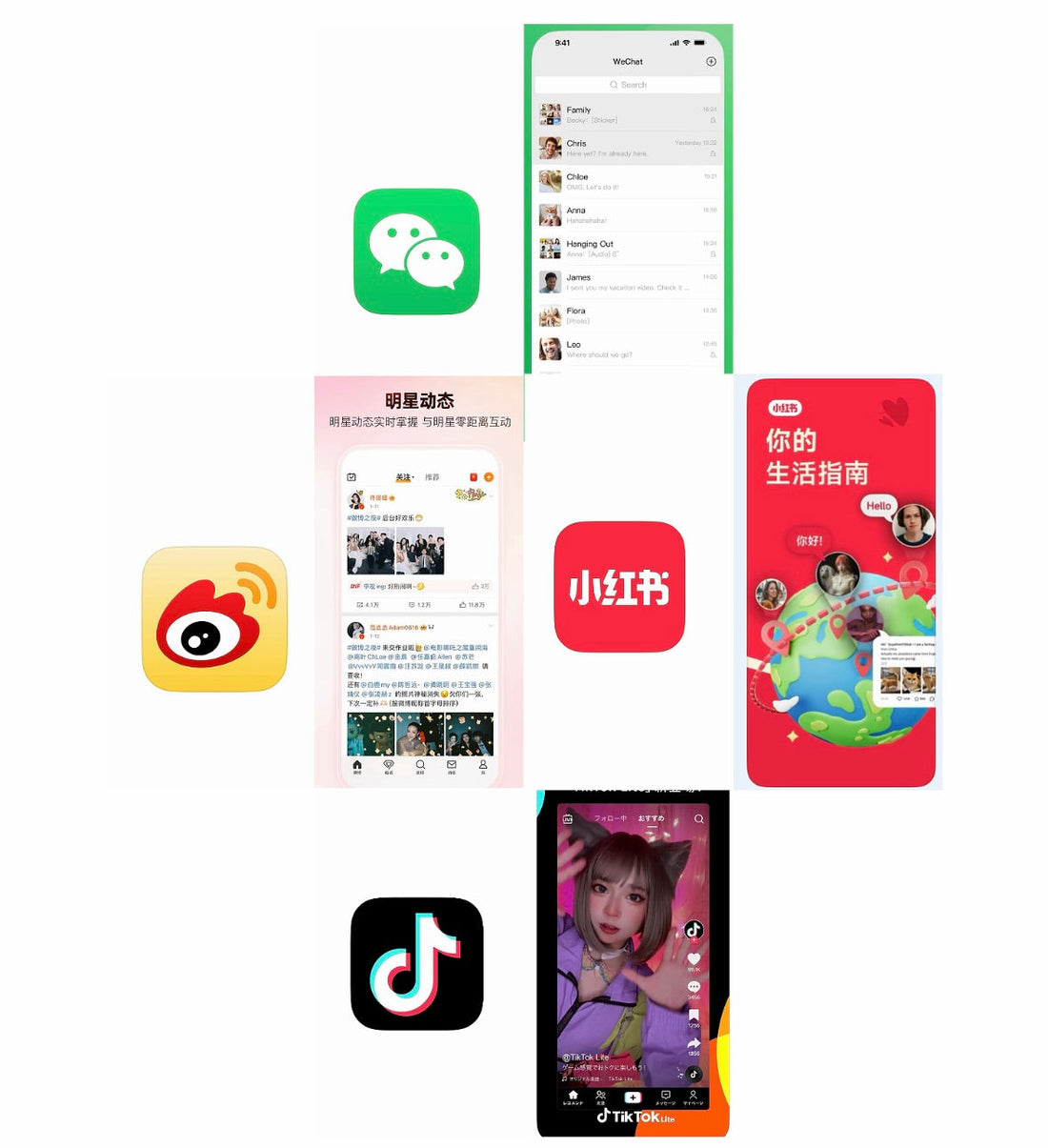
A guide to traveling around China's social media: A comprehensive guide to the four major apps: Xiaohongshu, WeChat, Douyin, and Weibo
If you're visiting China for the first time or have ever wondered, "What exactly do Chinese people do online?" you'll quickly find out. In China, Facebook, Instagram, and X (formerly Twitter) aren't the main players. Instead, the digital lives of Chinese people are dominated by four other "big apps": Xiaohongshu, WeChat, Douyin, and Weibo. These aren't just social media apps; they function as massive platforms, combining marketplaces, payment tools, and information sources.
This guide will help you understand and take advantage of China's digital world by providing detailed information on each service's role, user demographics, global expansion, and even the number of users overseas.

1.小红书(Xiaohongshu / REDnote)
In a nutshell, it is "lifestyle discovery + community e-commerce." It can be described as a photo-centric TikTok, or as a "Dianping (the Chinese version of Tabelog/Gurunavi) + Amazon."
Main features: "Notes" feed consisting of photos and short videos; Powerful hashtag search: Searches such as "Shanghai weekend recommendations" can sometimes yield more useful information than Google
"Sowing seeds" flow: User experience sharing → Comment → Product link → In-app payment Live commerce/local group purchasing (GMV to exceed $10 billion by 2024)
Key Users
Mainland China: Mainly women aged 18-35 (70%) from 1st and 2nd tier cities. High consumption and experience-oriented.
abroad:
1. International students/Chinese purchasing agent (proxy purchasing agent)
2. In January 2025, concerns about TikTok's regulation in the US led to an influx of 700,000 users. The DAU peaked at 1.3 million, then stabilized at 800,000.
3. Young women in Thailand, Singapore and Malaysia.
Global Response
Available for download in 81 regions on the App Store/Google Play. No Chinese phone number required. The UI can be selected in English, but the content is mostly in Chinese.
Number of foreign users
According to Sensor Tower (as of March 2025), the DAU outside of mainland China is between 6.1 million and 8 million. This breaks down into 800,000 in the US, 2.2 million in Thailand, and 1.5 million in Singapore and Malaysia. Compared to TikTok (MAU 1.58 billion), it is characterized by a "small but high added value" user base.

2. WeChat
In a nutshell, it is the Chinese "Swiss Army knife": chat is just the entrance, and the main focus is payment, mini-apps, and government services.
Main features Chat: text, voice, video calls, group chat Moments (timeline): similar to Facebook, but only visible to friends WeChat Pay: QR scan payment, splitting bills, utility bill payments, insurance, asset management Mini programs: over 2 million "applications that do not require installation"
Official accounts: Information hubs for media, businesses, and governments
Main users: Mainland China: 1.3 billion MAU. Covers almost all age groups and regions.
abroad:
1. Chinese and international students (60-70 million)
2. Traders and guides with China 3. Popular as a payment method in Chinese communities in Malaysia, Singapore, and Thailand 4. Increasing number of users in Russia and Central Asia
Global Response
Available in over 200 countries and regions, and supports over 20 languages.
WeChat Pay: QR payment has been introduced in 69 countries and regions, but full-scale use is limited to duty-free shops and department stores catering to Chinese tourists. From 2024, cashless payments will be possible within China if you link your Visa or Mastercard to WeChat Wallet.
According to Tencent, the number of overseas MAUs is 100-120 million (including Chinese users). If we limit it to non-Chinese users, the number is roughly 15-20 million, mainly from Southeast Asia and Russian-speaking countries.

3. Douyin vs TikTok
In a nutshell
Although they are twin apps operated by ByteDance, Douyin is for mainland China only, while TikTok is for global use, and data is also completely separated.
Key Features
Vertical short videos of 15 seconds to 10 minutes. They are characterized by their extremely high recommendation accuracy.
Live streaming: tipping, live commerce, paid ping-pong calls E-commerce closed loop: Douyin store, Groupon, food delivery services AR effects and templates are updated monthly and are leading global trends.
Main users: China's Douyin: 700-800 million DAU. Most users are between 18 and 40 years old, but it is used by a wide range of age groups, from 8 to 80 years old.
TikTok: Global MAU: 1.582 billion (Statista, April 2024). Gen Z accounts for over 60%, with the top five countries being the United States, Brazil, Indonesia, Mexico, and Vietnam.
Global support TikTok: Available in over 150 countries (some countries banned, including Iran and China).
Douyin: Available only on the App Store in mainland China. Requires a Chinese phone number.
Number of foreign users
TikTok itself is "Douyin for foreigners." Therefore, 100% of foreigners use TikTok. There are almost no cases of foreigners registering for the "Chinese version of Douyin."

4. Weibo
In a nutshell
It is like a Chinese version of "Public Square" or "X (formerly Twitter)," with posts limited to 140 characters. It plays a role in shaping public opinion and disseminating topics.
Main features Real-time trend search (hot search)
Fan club "Super Topic": A base for supporting and supporting idols, live streaming, e-commerce display window, long-form article posting, official platform for government, media, and companies
Main users Mainland China: MAU 580 million. Over 50% are aged between 18 and 30, and the app is widely used in first to third tier cities.
Overseas: The fan base includes international students from the early days, Korean Wave and Asian stars. Hong Kong and Taiwanese stars, Korean idols, and European soccer clubs also have English accounts.
Global compatibility: Available for download from app stores around the world. The UI can be selected in English, but the content is mainly in Chinese.

A practical guide for foreign users
1. Create an account You can register for Xiaohongshu, Weibo, and TikTok using an overseas phone number.
WeChat may require "friend-assisted authentication." It will be smoother if you ask a friend who already uses WeChat to scan the QR code.
2. Language: 90% of the content on Xiaohongshu and Weibo is in Chinese. Use your browser's translation function.
On WeChat, you can use the "Translate" function by long pressing on a conversation, but most of the mini programs are in Chinese.
3. Payment When traveling to China: If you pre-register your Visa or Mastercard with WeChat Wallet, you can make QR payments at over 90% of stores.
Overseas residents: WeChat Pay may only be available in Chinese stores or stores catering to Chinese tourists.
4. Content Gap There can be a time difference of up to three months between trending topics on Douyin and TikTok.
Xiaohongshu prioritizes local content based on your IP address, so if you're using a US SIM card, for example, you'll see more content from US creators.
summary
Within China, each of these apps plays a different role.
Xiaohongshu: "A search engine for quality life"
WeChat: "ID + wallet + phone book"
Douyin: "The ultimate tool for killing time"
Weibo: "The source of the trending topics"
On the other hand, their functions and roles are slightly different overseas.
TikTok: A leader in global cultural trends.
WeChat: Serves as a key hub for communication and payments in Chinatown and trade areas.
Xiaohongshu: Rapidly growing as TikTok users' "Plan B."
Weibo: Still a mecca for niche Chinese-language entertainment.
Understanding these four apps will not only open the door to China's 1.4 billion digital lives, but also empower you to move freely within the Chinese network that spans more than 200 countries and regions around the world.
